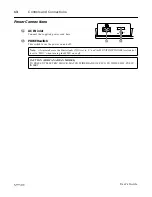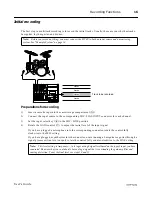
1
Precautions
User’s Guide
Precautions
1
Avoid excessive heat, humidity, dust, and vibration.
Keep the MT4X away from locations where it is likely to be
exposed to high temperatures or humidity, such as direct
sunlight, near radiators, stoves, etc. Also avoid locations which
are subject to excessive dust accumulation or vibration which
could cause mechanical damage.
2
Avoid physical shocks
Strong physical shocks can cause damage. Handle the unit with
care.
3
Clean with a soft dry cloth
Never use solvents such as benzine or thinner to clean the
MT4X. Wipe it clean with a soft dry cloth.
4
Do not open the case or attempt repairs or modification
yourself
The MT4X contains no user-serviceable parts. For other than
routine cleaning, refer all maintenance to qualified YAMAHA
service personnel. Opening the case and/or tampering with the
internal circuitry will void the warranty.
5
Make sure power is off before making or removing
connections
Always turn the power OFF prior to connecting or
disconnecting cables. This will prevent damage to the MT4X as
well as other connected equipment.
6
Handle cables carefully
Always plug and unplug cables — including the AC cord — by
gripping the connector, not the cord.
7
Always use the correct power supply
The MT4X is sold configured to the appropriate power
specifications for the local area. The power supply voltage and
power consumption are listed on the bottom panel. If you move
to an area with a different AC mains voltage, be sure to check
with your nearest YAMAHA dealer before using the unit.
8
Keep the heads and tape path clean
To ensure consistent high performance and sound quality from
the MT4X, it is important to clean the heads and tape path
regularly — ideally before each recording session. Use a
cleaning kit specifically designed to use with cassette tape
equipment.
9
Use only high-quality chrome cassette tape
The MT4X is designed to be used with Chrome tape (CrO
2
tape
— Bias: HIGH or TYPEII position; EQ: 70
µ
s). It will not work
properly with Ferrichrome tape formulations. You may
experience high frequency distortion if you use such tapes.
The use of tapes longer than 90 minutes (C-120 and longer) is
not recommended. These tapes are much thinner and therefore
prone to poor performance or failure.
TDK SA 46 – 90 and Maxell XLII 46 – 90 are recommended.
10 Handle the cassette tapes properly
You should fast forward and rewind new tapes before you
record on them. This will prevent any possible binding that
could be caused by the tape being tightly wound at the factory.
It is best not to use the first and last 20 seconds of a tape. The
splice between the leader and the tape can cause distortion.
When loading a cassette, check that the tape is not loose, then
load the tape firmly into the cassette compartment. If the tape is
not loaded properly, the unit may jam or otherwise malfunction.
11 Use the dbx™ switch correctly
To obtain the best possible sound quality, you should always use
the dbx™ noise reduction system to playback tapes that were
recorded with the dbx™ system on. If the tape was recorded
without dbx™, turn the noise reduction system off.
The dbx™ noise reduction system was manufactured based on a
patent licence from THAT Corporation. dbx is a trademark of
Carillion Electronics Corporation.
Contents
Precautions
1
Introduction
2
Features2
Structure of the MT4X3
1 Controls and Connections
5
Channel Modules6
Master Module7
Recorder Controls8
Transport Controls10
Multi-function Display10
Front Panel Connections11
Rear Panel Connections12
Power Connections13
2 Example System
14
3 Recording Functions
15
Monitoring15
Initial recording16
Overdubbing19
Punch-in/out recording21
Ping-pong recording29
Mixdown32
4 Synchronization
34
FSK recording35
Synchronized playback36
Synchronized mixdown39
5 Memory Functions
41
Memo Function41
Repeat Function42
Recording Levels Function42
Appendix
44
Troubleshooting44
Maintenance45
Specifications46
Block Diagram48
Dimensions49
Tracking Sheet49
Glossary51




































